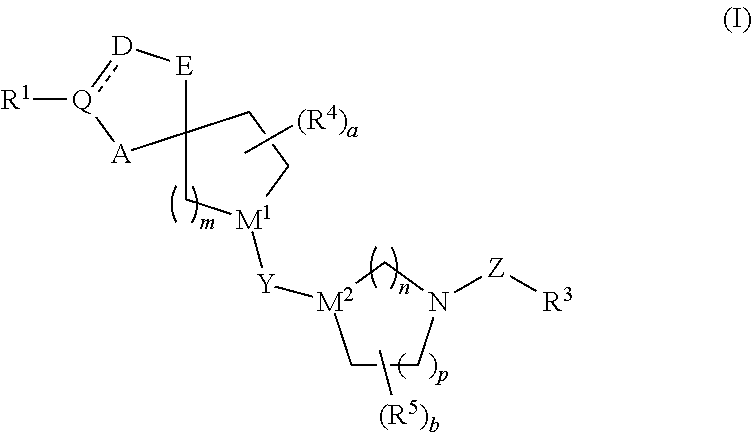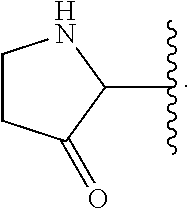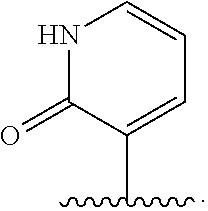Tricyclic spirocycle derivatives and methods of use
a technology of spirocycle and derivatives, applied in the field of tricyclic spirocycle derivatives, can solve the problems of increased and premature morbidity and mortality, increased risk of macrovascular and microvascular complications in diabetic patients, and increased plasma insulin levels
- Summary
- Abstract
- Description
- Claims
- Application Information
AI Technical Summary
Benefits of technology
Problems solved by technology
Method used
Image
Examples
example 1
Preparation of Compound 1
[0229]
[0230]Sodium hydride (50% dispersion in mineral oil, 0.235 g, 4.8 mmol) was added to a stirred solution of 1,3-dihydro-1-phenyl-2H-indol-2-one 1a (2.0 g, 9.6 mmol) in dimethylacetamide (25 mL). To the resulting solution was added bis(2-chloroethyl)amine (1.7 g, 9.6 mmol) in benzene (25 mL) at room temperature. The resulting reaction was heated to about 50° C. and allowed to stir at this temperature for 0.5 hours, then additional sodium hydride (0.235 g, 4.8 mmol) was added and stirring was continued for 2 hours. The reaction mixture was cooled to room temperature, diluted with benzene and treated with water. The organic phase was dried over MgSO4, filtered and concentrated in vacuo to provide compound 1b.
Step 2
[0231]
[0232]A sealed tube (15 mL) was charged with spiropiperidine 1b (36.3 mg, 0.115 mmol), 1-tetrahydropyran-4-ylmethyl-piperidine-4-lithium-carboxylate 1c (38 mg, 0.150 mmol, 1.3 eq., was prepared as described in U.S. Patent Publication No. 20...
example 2
Preparation of Compound 2
[0233]
[0234]A sealed tube (15 mL) was charged with spiropiperidine 2a oxalate salt (32.1 mg, 0.083 mmol, Peakdale Fine Chemicals LTD), 1-tetrahydropyran-4-ylmethyl-piperidine-4-lithium-carboxylate 1c (27 mg, 0.108 mmol, 1.3 eq), EDC (24 mg, 0.124 mmol, 1.5 eq), BtOH (17 mg, 0.124 mmol, 1.5 eq), DIPEA (0.1 mL) and dichloromethane (2 mL). The resulting mixture was heated at 65° C. for 15 hours, then cooled to room temperature, diluted with dichloromethane (50 mL) and washed with 1 N aqueous NaOH (30 mL). The layers were separated and the aqueous was extracted with dichloromethane (2×25 mL). The combined organic phase was dried over MgSO4, filtered and concentrated in vacuo to provide a crude oil that was purified using preparative TLC (SiO2, dichloromethane:0.4 N NH3 in MeOH 95:5) to provide compound 2 (21 mg, 48%) as a colorless foam. MH+=523
example 3
Preparation of Compound 3
[0235]
[0236]NaHMDS 1 M in THF (50 mL, 50 mmol) was added to a stirred solution of 1,3-dihydro-2H-indol-2-one 3a (1.33 g, 10 mmol) in dry THF (20 mL) at −78° C. and the mixture was stirred for 30 minutes. Then N-Benzyl-N,N-bis(2-chloroethyl)amine hydrochloride (2.68 g, 15 mmol, 1.5 eq) was added and the resulting mixture was stirred for 15 hours and slowly warmed to room temperature. The mixture was diluted with dichloromethane, then water. The organic phase was dried over MgSO4, filtered and concentrated in vacuo to provide a residue which was purified using column chromatography (dichloromethane:MeOH 95:5) to provide compound 3b (1.7 g, 73%).
Step 2
[0237]
[0238]Solid KHMDS (0.78 g, 3.94 mmol, 1.6 eq) was added to a stirred solution of oxindole 3b (0.72 g, 2.46 mmol) in dry THF (12 mL) at 0° C. and the mixture was stirred for 30 minutes, during which time it was allowed to warm to room temperature. The mixture was then cooled to 0° C. and 3,5-bis(trifluorometh...
PUM
| Property | Measurement | Unit |
|---|---|---|
| temperature | aaaaa | aaaaa |
| temperature | aaaaa | aaaaa |
| temperature | aaaaa | aaaaa |
Abstract
Description
Claims
Application Information
 Login to View More
Login to View More - R&D
- Intellectual Property
- Life Sciences
- Materials
- Tech Scout
- Unparalleled Data Quality
- Higher Quality Content
- 60% Fewer Hallucinations
Browse by: Latest US Patents, China's latest patents, Technical Efficacy Thesaurus, Application Domain, Technology Topic, Popular Technical Reports.
© 2025 PatSnap. All rights reserved.Legal|Privacy policy|Modern Slavery Act Transparency Statement|Sitemap|About US| Contact US: help@patsnap.com



